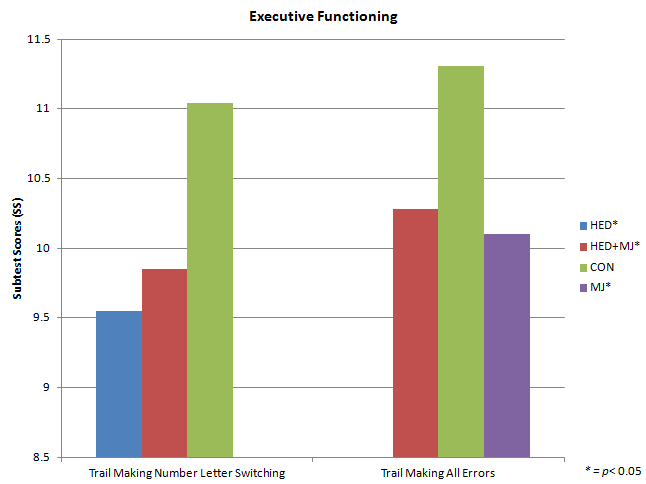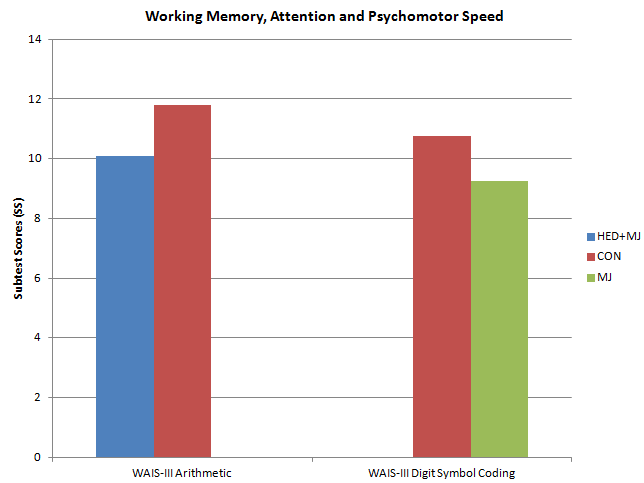How Does Alcohol Use, Marijuana Use, or Both Together Impact the Adolescent Brain?
The potential impact of marijuana and alcohol use on adolescent brain development is important to understand because marijuana and alcohol use are often initiated during adolescence.
Alcohol and marijuana are the most commonly used substances among adolescents and research suggests that adolescents experience heightened vulnerability to the deleterious effects of both.
Heavy and recent alcohol use in adolescence is associated with poorer neuropsychological outcomes compared to those of nonusers, and disrupts normal neuromaturational processes.
While many studies examine either the impact of marijuana or the impact of alcohol use on the brain separately, this study by Winward and colleagues examines concomitant use (using both alcohol and marijuana at the same time). The authors compared neuropsychological performance among alcohol using, marijuana using, and concomitant users, and non-using controls (n=128) in order to examine the effect of alcohol and marijuana on neuropsychological processes after 4 weeks of monitored abstinence.
A neuropsychological test battery was administered by trained neuropscyhometrists to assess the following domains: executive functioning, learning and memory, visuopatial construction, working memory, attention and psychomotor speed, and language and achievement. Four weeks was determined to be sufficient time for acute withdrawal symptoms to abate and for the THC from the marijuana to be eliminated from the body. The authors wanted to examine overall neurocognitive functioning after one month of sustained abstinence and abstinence was confirmed through biological testing.
Participants (N=128) were between the ages of 16-18 years old, 35% female, 75% Caucasian, typically from lower-middle to upper-middle class families, of average to above-average intelligence, and were classified by substance use into one of the four groups below:

Winward and colleagues found significant differences in neuropsychological test performance based on a participant’s substance use history group classification.
When examining executive functions, HED and HED+MJ performed 11-14% worse than the control group on the D-KEFS Trail Making Number-Letter Switching test which requires the test taker to complete 5 tasks including number sequencing, number-letter switching and motor speed that differentiates weaknesses in visual scanning, mental sequencing, and motor speed/control from deficits in cognitive flexibility and control. The accuracy rates were 10% higher in the control group compared to MJ and HED+MJ for the executive functioning tests.
Winward and colleagues define episodes as the number of days on which a substance was used in a participant’s lifetime and “heavy episodic drinking episode” was used to describe the number of days when a male participant consumed 5 or more drinks, 4 or more for females, within a 2 hour period.
Groups were similar on socio-demographic factors and the authors matched groups based on common substances used by lifetime episodes, frequency of recent use, days since use at study initiation and age of onset of regular use. The Heavy Episodic Drinkers (HED)+ Marijuana (MJ) drank alcohol approximately 1-2 times per week and the MJ and HED+MJ reported smoking marijuana approximately 4-5 days per week.

An overall group difference was found with Heavy Episodic Drinkers (HED) performing 0.96 standard deviations poorer than the Control Group (CON) when recalling a verbal list, which is part of learning and memory. HED also performed 0.71 standard deviations below CON, and HED+ Marijuana (MJ) performing 0.48 standard deviations below CON when examining total recall. MJ performed 0.67 standard deviations poorer than CON when recalling a verbal list with category cues (e.g. reminding participants that all of the words on the verbal list are about a specific topic). No group effects were found for verbal word-listing learning, long delay (20 minutes) free recall, total recognition discriminability or accuracy on a 30 minute delayed recall.
The authors did not find any significant group differences on the visuospatial tasks; however, they did find group differences when looking at working memory, attention and psychomotor speed.
The HED+MJ performed 14% worse than the CON group. Additionally, MJ performed 14% more slowly on the visual-motor speed/coordination and visual working memory task than the CON teens. No group differences were found when looking at the visual scanning condition or the Number or Letter sequencing tasks.

The authors did find a group effect when looking at language and achievement, with Heavy Episodic Drinkers (HED) performing 6% worse than the control group (CON teens), but no group effect was found when looking at vocabulary.
Winward and colleagues then combined the substance groups (HED, MJ and HED+MJ) and found that more lifetime alcohol use was associated with a lower WAIS-Arithmetic score (used to measure working memory, attention and psychomotor speed), and having more alcohol withdrawal symptoms was associated with lower performance on the D-KEFS Trail making Number-Letter Switching test (used to measure executive functions).
Additionally, having more alcohol withdrawal symptoms was also related to a higher error rate on the D-KEFS Trail Making visual scanning task (used to measure attention). More lifetime marijuana use was associated with having a higher false positive error rate on a verbal memory task. Additionally, an earlier age of onset of regular marijuana use was associated with slower psychomotor speed on the D-KEFS Trail Making Motor Speed.
In summary, Winward and colleagues found that teens with histories of heavy drinking showed poorer cognitive flexibility, recall and semantic organization of verbal information and reading achievement when compared to non-using peers. These differences in cognitive flexibility and verbal recall were also seen in teens who used both marijuana and alcohol but not in those who primarily use marijuana.
This study involved youth early in their drinking careers which suggests that decreases in cognitive decrements in visuospatial recall and verbal learning could emerge after continued heavy drinking. Youth with heavy marijuana use had poorer task accuracy, verbal memory, and psychomotor speeds compared to their non-using peers. Users in the HED+MJ were found to show impairments on the arithmetic task that evaluates working memory, attention and mathematical abilities which suggests that the concomitant use of alcohol and marijuana uniquely effects working memory which is thought to be modulated by the dorso-lateral prefrontal cortex. Greater lifetime exposure to alcohol was associated with worse performance on the mental arithmetic task for concomitant users, which is in line with previous findings that the use of marijuana may enhance sensitivity to the cumulative effects of alcohol.
IN CONTEXT
Teen marijuana use has increased substantially during the past 10 years in the U.S, and recent laws legalizing recreational and medical marijuana use in several states will increase the drug’s availability, suggesting these higher prevalence rates will likely increase.
The overlap between brain maturation and the initiation of substance use during this crucial developmental stage could have important implications for their day to day functioning. In light of these trends, studies that help us understand the effects of substance use on brain development and parallel cognitive functioning, and, in particular, those where marijuana use is measured both separately from and in combination with alcohol, become increasingly more valuable.
In this study, neuropsychological differences were found between those who were heavy episodic drinkers, protracted marijuana users and those who used both alcohol and marijuana. This is an important look at the ways in which heavy substance use may still impact individuals after a month of sobriety.
- LIMITATIONS
-
Two limitations in this study may limit the generalizability of these results.
- A lack of a baseline cognitive assessment before abstinence
- Authors were unable to examine differential rates of recovery or baseline functioning between heavy drinkers and heavy MJ users. Regardless of those limitations, this study is an important first step at examining how real world functioning and problem solving may be impacted alcohol and marijuana use during adolescence.
CITATIONS
Winward, J. L., Hanson, K. L., Tapert, S. F., & Brown, S. A. (2014). Heavy alcohol use, marijuana use, and concomitant use by adolescents are associated with unique and shared cognitive decrements. Journal of the International Neuropsychological Society, 20(08), 784-795.

